Client Experience Design
Let’s be honest: We designers can be difficult to work with. We might come from a controversial company culture, work an unconventional schedule or get impatient whenever our Internet connection is slower than the speed of light. Would you be at ease with a service provider who matches this description?
When talking to potential clients, be aware that many will have never solicited a professional design service and likely have little understanding of the design process itself. Keep in mind, too, that some clients have had a poor experience in the past. For many clients, it can be an anxious jump into the deep unknown, a big financial investment steeped in risk.
But why should any of this matter to us? After all, it’s not our money. Being rewarded for our time and effort should be all that matters, right? This is true to an extent; our knowledge and experience shouldn’t be seen as a free commodity. However, at times, a little patience and empathy are required on our part.
Many designers will agree that clients, for the most part, need us to guide them through the design process (minus the industry jargon), to ask the difficult questions and ultimately to reassure them by delivering measurable results.
What Is Client Experience?
In essence, client experience is the sum of all experiences between a client and the service provider over the duration of their relationship. Whereas customer experience focuses on the relationship between a client and their customers through one or more services or products, client experience focuses solely on the working relationship between a client and the service provider — in our case, the designer — a relationship whose purpose is to achieve measurable business and commercial goals.
A solution that improves the customer experience but doesn’t reflect well commercially nor complement the workflow of internal teams would be of little value to the client.
"Designers need to understand their customers. And in many cases, the customer is the person who purchases the product, not the person who actually uses it." – Donald Norman
We should regard clients as our primary customers, for they are the ones who pay the bills. The better the result and experience, the more likely they’ll pass any future work your way. Of course, being a good service provider doesn’t necessarily mean saying yes to whatever the client wants.
It means carefully explaining and providing to clients what they need in order for the project and their business to succeed, and being pleasant to work with along the way. While being a user advocate is great, we don’t necessarily have to be right about everything. What we do need to do is to enact positive change for the client to improve their customer experience.
Clients And Stakeholders
The client could be an individual, a startup, a department in a corporation or the corporation itself. You could be liaising with the CEO, the CTO, managers, colleagues and participants from a variety of departments, coworkers, peers — people who ultimately have a viable and legitimate interest in the work you’re doing and the outcome of the project. We often refer to such people as stakeholders.
In more complex environments, such as large corporations, you’ll rarely have direct access to C-level executives. However, be prepared because they will probably take an interest at some point. Remember that the responsibility of your lead contact is to inform the senior team on the progress and direction of the project.
Whether a project’s team consists of one or more stakeholders, you can be certain of one thing: Stakeholders will at some stage express differing and potentially conflicting opinions about a project. At the start of a project, stakeholders will often depict their concerns as being high priority. These opinions (political, procedural, financial) are often based on personal experience and on the experiences of those in their department.
Given human nature, this shouldn’t be a surprise. Nevertheless, your responsibility is to take everyone’s needs into account, to balance them out and to understand the bigger picture. Just improving the client’s overall customer experience is not enough. For meaningful and long-term success and to effectively support the customer experience going forward, change has to start within the organization. Provide the core team with tools and processes to manage, solve or even hack internal conflicts, to collect meaningful feedback and to seek approval for pieces of work.
Let’s begin by seeing what we can do to improve the customer experience for our clients. We’ll cover five categories of guidelines:
- Demonstrate value.
- Develop shared understanding.
- Set expectations.
- Facilitate collaboration.
- Detach.
Demonstrate Value
Each experience starts way before first contact has been made, meaning that you can delight a client without even realizing it.
Be Recommendation-Worthy
Word of mouth is often the best form of marketing. A good reputation sets the stage long before a client approaches you. Since Creative Nights’ founding in 2009, we’ve almost always obtained new clients through word of mouth. Exposure via articles, conferences and workshops certainly solidified what we do. In the end, it often comes down to the reputation we’ve built and the results achieved in previous projects.
"The keys to getting referrals: 1. Be pleasant to work with; 2. Do good work" – Mike Monteiro
One of the best ways to delight a client even before they’ve met you is to be recommendation-worthy. Clients love hearing about good service providers, because it frees them from having to spend countless hours writing RFPs (which forces the client to define the problem and solution even before the project has started), as well as eases the anxiety of purchasing services from someone completely unknown.
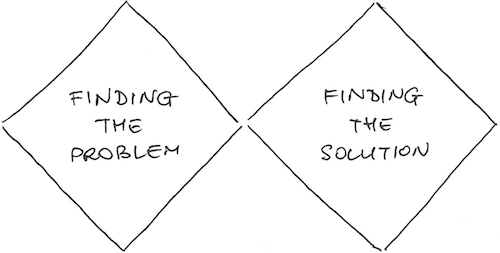
Show, Don’t Tell
When you’re selling, be as objective as possible. Instead of telling clients how great you are, share the results you’ve accomplished for previous clients and promote their successes. Rather than explaining your process in detail, why not engage them in your process? You could tell a client a hundred times how easy you are to work with, or you could just be easy to work with. It’s an old cliche but actions speak louder than words!
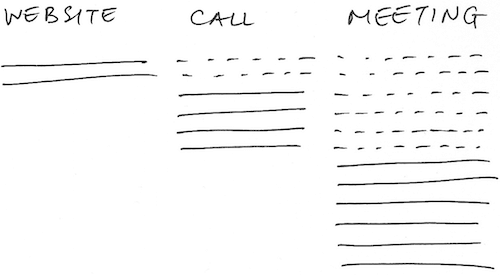
Disclose Gradually
There’s no need to tell your whole life story on the first date. For instance, on your agency’s website, leave something for the second and third date. You’ll be spending weeks if not months working together, so let the client discover what they need to know simply by working with you. If it’s controversial, refrain from talking about your company’s culture, because it’s often specific to the company.
We do, however, find culture to be a good topic of discussion once a working relationship has developed and mutual trust has been established. Furthermore, if you talk about an open-ended budget, you run the risk of frightening them away. You’ll have plenty of time to discuss the budget during the negotiation phase.
Be Ready For Mission Impossible
At times, you’ll be asked to do something you’ve never done before. If you communicate to the outside world that you do not take on anything but a specific set of services, then potential clients could easily pass you by — although, you might not care if you really are not open to a client’s particular challenge. In 2009, a corporate client approached us to redesign the user interface of its customer entertainment system. Its initial brief was for us to create an interactive prototype that could be deployed onto set-top boxes preinstalled with a custom-built operating system running JAVA applications.
At first, such an undertaking seemed to be well outside our comfort zone, considering that at the time we had never developed an interface in a language other than HTML, CSS and JavaScript. Rather than dismiss the challenge altogether, we took time to talk to the client, to ascertain what they hoped to gain from the prototype and to offer our thoughts. By the end of our discussion, the client was happy for the prototype to be delivered as a web page. As it happened, they really only wanted the interactive prototype to serve as a proof of concept by which they could demonstrate new design ideas and interactions.
As long as we were able to showcase the prototype on a full screen, they weren’t particularly bothered about the underlying technology. That client was one of our first and one we still work with to this day — on a variety of interesting projects.
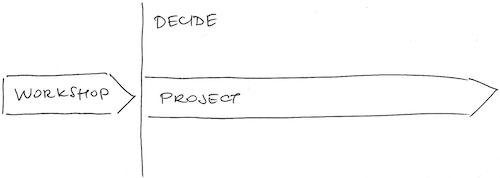
Start With A Workshop
Start small to establish mutual trust. If a client is unsure about how they wish to proceed or is sensitive to the risk of your impact on their business (especially with no prior experience to fall back on), then hold an in-house workshop. It will give you an opportunity to prove your value to the client and allow the client to get to know you better. Bear in mind that a workshop is not an excuse for a full-blown sales pitch, but rather a good opportunity to assist and educate the client.
Furthermore, considering that the cost of holding a workshop is usually small, the people you’re liaising with will probably not need approval or commitment from senior management. This means that work on the project can begin much sooner, and it is a relatively risk-free trial for the client. If you succeed, they’ll be less apprehensive about trusting you with a bigger project. If it fails, then the damage will not be as severe — if nothing else, the client will have learned something useful.
Focus On The Hole, Not The Drill
When engaged in the initial conversations with a client, refrain from using industry jargon or pushing specific tools or techniques. While atomic design, BEM architecture, visual inventories and responsive web design are often vital to the work we undertake, selling your expertise in solving problems is usually better than focusing on the tools you use to do so. As mentioned, less talk and more work: Get in, start working, and introduce tools as needed.
Develop Shared Understanding
Learn about the client’s context and their needs, making sure that all key stakeholders are pushing in the same direction.
"Teams that attain a shared understanding are far more likely to get a great design than those teams who fail to develop a common perception of the project’s goals and outcome." – Jared Spool

Audit Everything
Do your homework and conduct an audit prior to kicking off the project. You could audit the following:
- information architecture,
- content,
- interface patterns,
- user actions,
- anything else that would help you better understand the project.
The best way to grasp what’s happening with a client’s website is to put each piece of relevant information in a spreadsheet and then to sort and classify the information in different ways. In the words of information architect Christina Wodtke, you need to inhabit the data.
It doesn’t need to be elaborate, but auditing will help you to prepare for those meaningful conversations with the client. For example, you could evaluate the information architecture by conducting an online card-sorting test and inviting friends to participate. For such work, our tool of choice is OptimalSort.
Also, evaluate the content by assigning each piece of information to the intended user group or content type. List all of the UI patterns you can find and classify them by complexity. Next, list both the common and specific goals a user should be able to accomplish on the website by dividing them into discrete tasks.
Conduct Usability Testing
You could review and test a client’s current product or even analyze the direct competition. If you don’t have the time or resources for more comprehensive research, consider using a free service such as Peek by UserTesting. It will provide you with some basic insight into users as well as highlight areas for improvement. Again, the goal of this activity is to gather as much data as you can as early as possible.
Forget No One
Talk to all stakeholders. Listen to what they say, and write it all down. Next, prepare a report and distribute it to all stakeholders, asking them to address any mistaken perceptions of their needs. In doing so early on in the process, there’s a good chance stakeholders will raise any issues. Include everyone, even stakeholders who are in conflict with other stakeholders. The goal is to identify roadblocks before you and the client invest too much time, money and effort.
Define The Project’s Goal
If a project is to succeed, the goal needs to be clear. However, stakeholders can often have different goals in mind at the start of a project, obscuring the real goal. For instance, some stakeholders simply wish to safeguard their position, while others push their personal or department’s agenda.
Our favorite question at the beginning of each project is, “How will you know whether we have succeeded?” Don’t be afraid to ask the question because it clearly communicates to the client that you really care about their success. Write down the answer to the question, keep it in mind throughout the project, and bring it up whenever you feel the project is swerving in the wrong direction.
Establish Policies
Project policies promote good practices and technical standards. Look to establish policies for the following areas:
- web standards conformance,
- content parity,
- performance budget,
- information budget,
- accessibility conformance,
- Google’s PageSpeed score.
Apart from a high level of quality being set for the final product, the key benefit of establishing policies for everyone is the increased focus they yield. When you limit the problem-solving boundaries, then finding a solution becomes much easier. Needless to say, two common creativity-boosting limitations are time and budget. Leverage them.
Prototype The Design Direction
Prototype early on to develop a sense of direction for the design, and share it with the client for feedback. Consider using visual inventories or sketches, or even configure a quick WordPress website to prototype content.
"The trick is to delay precise specification of the product requirements until some iterative testing with rapidly deployed prototypes has been done, while still keeping tight control over schedule, budget and quality." – Donald Norman, The Design of Everyday Things
Prototype as an opportunity to test hypotheses and demonstrate the potential failure of a project. Because specifications tend to evolve in the early stages of a project, you will be able to more quickly recover and adjust. The client will also come to better appreciate the value of failure and will be less afraid of it.
We often try to create a quick yet meaningful HTML and CSS prototype within a week of our first meeting with a client, because by this point we tend to understand the project’s goals well enough. The question we regularly ask is, “Did we get it right?” Considering that we haven’t invested much time yet, we can easily correct course or even start again.
Set Expectations
Break Down The Project
If the scope is not completely clear (and it rarely is), break the project down into smaller milestones. A good way to start is by identifying a minimum viable user action or feature (comparable to a minimum viable product) that has a potentially high return on investment and low risk — for instance, “find key information” or “get in touch.” The benefits of doing so are several:
- You get things done while the rest of the project is being scoped.
- As you work on a smaller part of the project, you get a better sense of the overall level of engagement required.
- Everyone will know early enough whether something doesn’t work as expected.
- You have an opportunity to introduce web design best practices on a smaller scale, such as modular or mobile-first design.

Create An Availability Plan
For many people in our industry, work can be a mix of on-site consulting, remote design and development, and traveling to and from conferences. There will be times when you have to switch focus to something else in the middle of a project or even go away on vacation. To minimize any client anxiety, stick to a schedule. Share a calendar with the client specifying the exact days (or weeks) you’ll be 100% devoted to their project. Be available on those days, and they’ll respect the days you’re unavailable.
- Always stick to the proposed schedule.
- Before taking a break, send the client a progress report, but not on your last working day. Give the client sufficient time to ask questions and for you to address their issues.
- Treat the client the way you would want to be treated. If you don’t call them on weekends, they won’t call you either. If you don’t send or answer email after hours, they’ll respect your time away from the office.
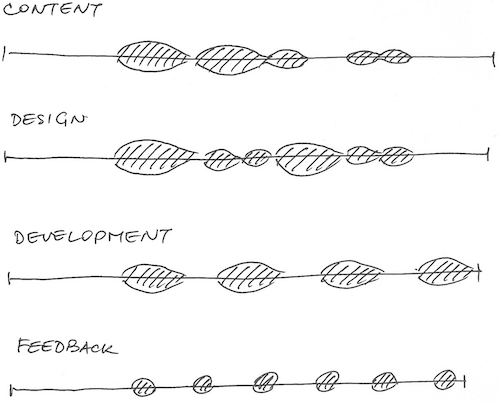
Turn The Project’s Timeline Into A Journey Map
Turn the project’s timeline into a customer journey map, pointing out to the client any challenging stages and interdependencies (for example, content and design) and the times when they’ll need to be engaged. Set deadlines for the client’s feedback, and be clear about the consequences of delays on both sides. Set reasonable expectations; clients usually have many responsibilities outside of the project.
Facilitate Collaboration
"Producing a good product requires a lot more than good technical skills: it requires a smoothly functioning, cooperative and respectful organization." – Donald Norman
Design sprints are structured, weekly problem-solving activities involving key stakeholders, and they are ideal for achieving fast yet effective results. While they have gained a lot of press recently, not everyone is in a position to organize a sprint in their project, and many project teams still need to fall back to a more traditional process. Fortunately, there’s always room for improvement.
Include Everyone
We’ve already talked about including all stakeholders, but this is so central to running a successful project that it’s worth repeating again. In the words of Tin Kadoić, a creative director from New York City and a leading advocate of design sprints, success is sometimes achieved just by getting the right people in the same room; everything else is easy.
As outsiders, we should be able to talk to anyone and persuade them to participate for the benefit of everyone. However, be aware that some in-house people and teams suffer from internal politics and so want to avoid any unpleasant situations. Even if the atmosphere of an organization is very unhealthy and some people or teams are incapable of sitting together in the same room, try to bridge the gaps using good old-fashioned diplomacy, working individually with each group.
Meet Them Where They Are
Be flexible. Adjust your processes to the client’s habits, rather than expecting the opposite. Meet them where they are so that it’s easier for them to engage with the project. If they use Microsoft Office, switch to Office. If they prefer Basecamp to Trello, use Basecamp. The most important thing is collaboration, so remove any obstacles that stand in the way.
Send Small Updates Often
When you send small updates regularly — assuming you’ve done your prep work and set expectations at the very start — the client can then focus on specific elements of the project. This is especially important at the beginning, when you’ll want to use broad strokes. If you invest too much time into polishing artefacts that you realize later on are not feasible, two things happen:
- You lose the motivation to start a new concept due to the time and resources already spent.
- The client gets distracted with the plethora of details and doesn’t know where to begin or what to look at, often resulting in the client focusing on and critiquing non-essential elements.
After you’ve established a general direction, small iterative updates are useful as part of an ongoing feature-specific design conversation.
Remind Clients How To Sketch
Encourage clients to sketch; they’ll be empowered to participate in the design process. Sketching games, such as Guess-a-Sketch, break the ice and reduce anxiety. Even simple sketching exercises, such as drawing boxes, triangles and circles, encourage even the least confident team members to contribute and participate. Most importantly, most people have fun when they’re sketching and quite often, with the freedom it affords, generate useful ideas.
Simple And Accessible Tools
Effective collaboration does not require the latest and greatest project management apps. More often than not, low-tech tools will suffice:
- to-do lists (created in Google Spreadsheets);
- prototypes (HTML, CSS and JavaScript);
- workshops (with client participation and a goal clearly set);
- design sprints (i.e. structured, weekly problem-solving activities);
- meeting minutes (if you write everything down and share it with the team, everyone will have the same understanding of what was decided on in the meeting).
Detach
Most of the time, when working with other people, ego is your worst enemy.
Have No Personal Preferences
If you are a designer, then you already know that design is not an art. Design is a practice of solving problems within limitations. There are usually multiple solutions to any problem, but the most common challenge is when different stakeholders believe their solution is the right one. In such cases, your personal preference doesn’t really matter because you’ll have plenty of options to choose from.
"Sometimes we have to be the one without opinions or preferences so we can weight all the opinions and find the best way forward for everyone involved." – Abby Covert
A designer should strive to facilitate a design-thinking process to ensure that decisions and options are in line with the project’s goals. You don’t have to generate ideas on your own. Do it in a group, but always be the one who controls the design process.
Make Others Look Good
When people you work with are successful, especially within their organization, you are one step closer to enacting positive change within that organization. If they are successful, they’ll promote customer experience best practices more effectively. It will also make it easier for them to implement design thinking in the next project, resulting in better products. Want to be a user experience designer? This is how you do it.
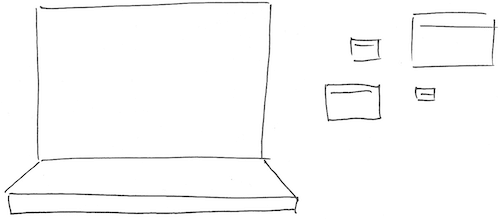
If You Love Something, Set It Free
Dave Rupert of Paravel made a great point at Smashing Conference Oxford 2013: Once you’re done with a project, how it’s implemented thereafter is out of your control. Our job is such that the client has the right to modify our deliverables. So, there’s no point in getting obsessive about every little mistake or, worse, getting defensive and badmouthing the client. Which brings us to the last point.
It’s In Our Hands
As designers, we love to build amazing products that make the end customer’s journey easier. We try to develop skills to understand the user, as well as methodologies to help us build accessible, usable and delightful products.
Because we openly share our knowledge with everyone in the design community, we are well equipped to apply our collective experience, knowledge and skills to improve the client-designer relationship, too. Help your clients become successful, because successful clients will enact positive change in their organization, which will lead to a better experience for end users. What are you waiting for? Go delight your clients!
Further Reading
- Passing The Holy Milestone: How To Meet Deadlines
- How To Spark A UX Revolution
- Stop Writing Project Proposals
- Examining The Design Process: Clichés And Idea Generation






 Agent Ready is the new Headless
Agent Ready is the new Headless SurveyJS: White-Label Survey Solution for Your JS App
SurveyJS: White-Label Survey Solution for Your JS App

